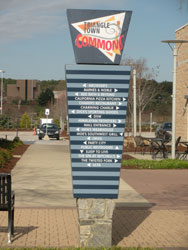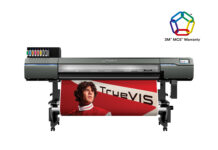A friend of mine was recently hired to design an identification pylon for an indoor tradeshow exhibit. He began by trying to get as much height on it as possible, but his client told him that they needed a pylon that also could be reduced in size (so as to fit size requirements for specific shows).
It’s easy to reveal the solution [drum roll]: Put something in between the sections of the pylon.
For the tradeshow exhibit, the reveal allowed for sections to be built where the middle sign cabinet or even the associated reveals could be taken out. Voíla! Lower height is achieved!
The question here: How does one make this break look clean and appealing?
This is the same conundrum sign companies frequently come up against when they design a large pylon but, because of sign codes, also have to utilize standard-size acrylic or lighting components.
Reveals occur in architecture at a remarkable rate: big gaps, small gaps, windows, bricks, expansion gaps, trim, etc. This could be attributed to aesthetic reasons—to break the monotony of a long, unending suface. After all, when a design is created as an unlimited, continuous, flat, white plaster wall, the reality of production is going to set in.
In the case of a sign pylon, the reveals help make it a simplified fabrication with sections that are easy to produce, handle, and install.
One post-and-panel system developed for a veterans hospital featured reveals made from one-by-one and two-by-two aluminum tube stock extrusions welded/adhered into frames and painted a subtle shade different from the adjacent face. This was an off-the-shelf solution and one that was easy to put in between the primary sections of the sign. With the sign supported on the sides, these reveals “went for the ride” between segments.

The general assumption is that a reveal is in the negative direction; that it goes into the sign and then portions of the sign are completed and stacked/attached like a layer cake. The puzzle then comes apart in reverse for any modifications.
The sign logic here may be to give the sign maker room to easily remove the retainer, especially if the standard retainer is accessible from the side and the face slides out.
On the other hand, an entire face with CNC-routed aluminum copy and acrylic backing will require you to take the whole frame out.
A reveal can be simply created with a face-mounted frame that is part of the main sign body. This is a great solution for multi-tenant, i.e. cohabitation, pylons with long length internal lighting.
Decoration is also a valid reason to add a reveal to a sign cabinet. The flourishes are often what creates the look and feel. Breaks in color can be accentuated with a dividing reveal.
An accurate and simple way to produce a reveal is to utilize standard-thickness materials and CNC-cut them out of plate aluminum or composite plastic into the needed shape.
The reveal doesn’t even need to be dimensional. It could be the lack of something—as if you’re looking straight through between the sections. If the main supports of the sign are on or towards the ends, this is easy to accomplish. It also deletes an element from the production list.
If you’re in the mood to go a little crazy here, consider making the reveal bigger then the cabinets. It serves the same function in production and adds a bit of pizzazz.
By Peter Perszyk
All photos (top to bottom): Peter Perszyk, Dave Forrest, Peter Perszyk.











